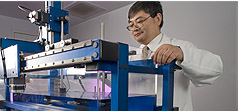Microbubble Dynamics
Dynamic Microbubble Behavior Using Ultra-High Speed Microscopy
We have developed the UPMC Cam, an ultra-high speed microscopy imaging system capable of acquiring images at up to 25 million frames per second under either bright-field or fluorescence light conditions. Such a system allows us to directly visualize the mechanics of a single oscillating microbubble or the dynamics of a microbubble’s interaction with another object or environment. This unique tool will help us better understand microbubble dynamics, mechanisms of microbubble mediated bioeffects, and improve their design for specific applications. Our ultra-fast imaging system may also have applications in imaging phenomena in other areas such as cell biology and microbiology that may occur at time scales smaller than ever before realized.

Overview of UPMC Cam. This system is capable of imaging microscopic bright field and fluorescence movies at 25 million frames per second for 128 frames, with a frame size of 920×616 pixels. Adapted from Chen X,…, Villanueva FS. Ultra-fast bright field and fluorescence imaging of the dynamics of micrometer-sized objects. Rev Sci Instrum 2013; 84.
An individual 7.04 μm phospholipid encapsulated gas microbubble situated in water, insonicated with a 1 MHz, 8-cycle tapered pulse at 0.1 MPa. Mode oscillation is observed.
An individual 2.88 μm phospholipid encapsulated gas microbubble situated in water, insonicated with a 1 MHz, 8-cycle tapered pulse at 0.25 MPa. Nonlinear oscillation is observed.
An individual 3.86 μm phospholipid encapsulated gas microbubble situated in water, insonicated with a 1 MHz, 8-cycle tapered pulse at 0.5 MPa. Fragmentation is observed.

An example of the data analysis performed on individual microbubble radius-time curves. (a) The raw normalized radius versus time curve, as extracted from an ultrafast frame rate microscopy recording of a 3.7-μm diameter microbubble, R/R0 and (c) its Fourier transform. After applying a band-pass filter around the transmit frequency (1 MHz in this case), panels (b) and (d) illustrate the resulting time and frequency domain representation of the radial oscillations at the fundamental frequency Rfun. The amplitude of this function is defined as the relative fundamental oscillation amplitude Afun. Adapted from Helfield et al. Individual lipid encapsulated microbubble radial oscillations: effects of fluid viscosity. J Acoust Soc Am 2016, 139.
Mechanisms of Action for Ultrasound-Microbubble-Mediated Therapy
The microbubble dynamic behavior obtained from the UPMC Cam can be used to study the mechanisms of action for ultrasound microbubble mediated therapies, such as sonothrombolysis and sonoporation.
Brightfield movie of multiple microbubbles oscillating adjacent to a thrombus (left) during ultrasound exposure (1 MHz, 1.5 MPa). Acoustic radiation force causes oscillating microbubbles to migrate towards the thrombus (a new microbubble enters the field of view from the right). Note the marked cyclic thrombus deformation in response to ultrasound-induced microbubble oscillations compressing the thrombus, and ultimate microbubble destruction or formation of smaller microbubbles. Adapted from Chen X,…, Villanueva FS. New insights into mechanisms of sonothrombolysis using ultra high speed imaging.. Ultrasound Med Biol 2014;40.

High-speed fluorescence recordings with UPMC Cam reveal a variety of microbubble coating behaviors not evident from brightfield recordings. For microbubble with a homogeneous coating before ultrasound (50 kPa), we observed homogeneous fluorescence during oscillation (A), “hot spots” (focal areas of increased fluorescence intensity) only during compression (B), or hot spots during oscillation that persisted after US (C), suggesting that lipids can reach speeds on the order of 1 m/s. For microbubble with hot spots before US, the hot spots persisted or intensified (D). Occurrence of hot spots during ultrasound could be due to buckling. At higher acoustic pressures, we also observed other phenomena: formation of a tail (E) that was not evident in BF, or a non-continuous lipid coating during the expansion phase (F), suggesting a ruptured coating correlating with deflation. Adapted from Kooiman K, Villanueva FS, …, Chen X. Unraveling lipid-coating movements of oscillating microbubbles--a fluorescence high-speed optical study. IEEE IUS 2014.
Microbubble Behavior Influenced by Viscosity
Ultrasound-stimulated microbubble dynamics have been shown to be dependent on intrinsic bubble properties, including size and shell characteristics. The effect of the surrounding environment on microbubble response, however, has been less investigated. In particular, microbubble optimization studies are generally conducted in water/saline, characterized by a 1 cP viscosity, for application in the vasculature (i.e., 4 cP). Using ultra-high speed microscopy, the oscillations of phospholipid encapsulated microbubbles were shown to be affected by fluid viscosity in a size- and pressure-dependent manner, resulting in behavior not entirely predicted by current microbubble models.

Example of experimentally determined diameter versus time plots obtained via ultra-fast speed microscopy for sized matched individual microbubbles in a 1 cP (solid) and 4 cP (dashed) liquid at (a) 100 kPa and (b) 250 kPa. For these microbubbles, the 4 cP liquid serves to reduce the amplitude of oscillation at both pressure levels. Adapted from Helfield et al. Individual lipid encapsulated microbubble radial oscillations: effects of fluid viscosity. J Acoust Soc Am 2016, 139.

Example of the effect of fluid viscosity on microbubble oscillation characteristics at 1 MPa. Selected still frames from an ultra-high speed recording for a 4.3-μm diameter microbubble in 1-cP liquid (top) and a 4.8-μm diameter microbubble in 4-cP liquid (bottom). Scale bar is 5 μm. The microbubble fragmented in 1 cP liquid and remained intact in 4 cP liquid. Adapted from Helfield et al. Fluid viscosity affects the fragmentation and inertial cavitation threshold of lipid-encapsulated microbubbles. Ultrasound Med Biol 2016.

The effects of liquid viscosity on microbubble behavior at high transmit pressures, displaying the percentage of microbubbles that undergo fragmentation as a function of pressure for microbubbles residing in 1-cP (gray bars) or 4-cP liquid (black bars). Error bars denote 95% confidence intervals (Clopper–Pearson interval), and stars denote statistical significance (p < 0.002) as determined with Fisher's exact test. Adapted from Helfield et al. Fluid viscosity affects the fragmentation and inertial cavitation threshold of lipid-encapsulated microbubbles. Ultrasound Med Biol 2016.


